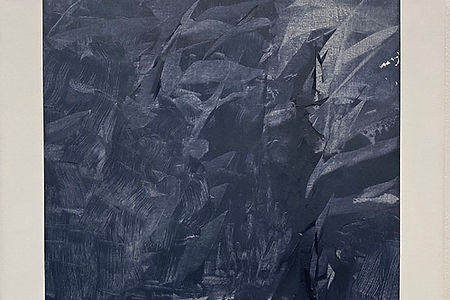Michael Brennan
Floating Weeds
At Minus Space
16 Main St., Brooklyn, NY
October 7-December 16, 2023
By Kit White, November 20, 2023
Image: Black Mountain Stars, 2021, Oil on canvas, 20 x 28 inches
Like all really good painters, Michael Brennan understands the mercurial nature of paint, how it embraces the dual identities of both material and image. He never forces paint to do something it doesn’t want to do. Instead, he lets it find itself and in so doing, finds the image it wants to make. This ability to grant paint its autonomy while at the same time controlling its direction is the crux of his talent and a sign of his mastery over paint’s sometimes fickle nature. What is immediately clear in this group of paintings at Minus Space, is that Brennan knows what he is doing and knows, also, that the paintings that have emerged from his wrist and palette knife have achieved the life in image that they sought.
Brennan’s paintings reference the world, or rather, they seek the world as a template onto which impressions, associations, history and imagination coalesce. It is as if the original Platonic image is not a specific referent, but a changeable, evanescent shadow out of which something iconic emerges. The titles of Brennan’s paintings evoke specific places and things, but to give these references a literal reading would be misleading and perhaps even miss the point of what pictures actually do. In Black Mountain Stars, for instance, a dark central mass of thickly applied paint, rising from the lower edge, tethers the image to the horizon-like bottom while shards of gloaming light surround the mass, halo-like, and make a “sky”. One might assume the mass to be the “mountain” and the flying shards the stars. But looking close into the paint, one sees the mineral content and crushed glass he adds to the paint, glitter and sparkle like stars, and Black Mountain can only refer to the pedagogic phenomenon that lit aflame the imaginations of a whole generation of American artists. And what those artists taught us is that the content of painting is a collaboration between a material we can know but an affect we can only imagine.
The images at Minus Space are highly focused extrusions of single sittings. This is in keeping with Brennan’s affinity for Japanese film and literature and the aesthetic of the lean and essential. Like the perfect choreography of calligraphy, he seeks the practice of studied spontaneity, in which the lessons of the wrist, once learned, are free to improvise like a good jazz riff. His paintings are all monochromes, of blues, grays, black and green. Again, the reduction of input leads to a maximum of concentrated output. His images are distillations of years of looking and practicing; listening to what the paint is saying as he herds its viscous molecules into a living thing. In these paintings, viscosity is more than a physical state, or a signifier of artfulness. It is a condition of being and a trigger for emotional response. As in the Japanese art he admires, there is no separation between the physical and the spiritual; they are a helix, inextricably bound to one another.

Floating Weeds, 2022, Oil on canvas, 20 x 28 inches

Marrow Road (Basho), 2022, Oil on canvas, 20 x 28 inches
The associations Brennan conjures sweep broadly from East to West.. In Marrow Road (Basho), the title suggests an homage to the haiku master, but this is a Western painting through and through. The flatness of the white bands on either side of the image conjures a doorway, and adds to the suggestion of space that holds a miasma of illusion laden strokes and slashes. It is a tumult relieved only by a chiaroscuro light that filters in from the top right. There is a sense of foreboding in this space that recalls the English painter John Martin’s depictions of the underworld, along with his sense of melodrama. The thick paint absorbs and reflects the light simultaneously, giving this already vertiginous space a slightly hallucinatory effect.
The exhibition takes its title from the single green painting “Floating Weeds”, a painting that is reminiscent of screens by the 17th century Japanese master Ogata Korin, with its expanse of flat space activated by small inflections of incident. Brennan takes the title and idea from the filmmaker Yasujiro Ozu’s film “A Story Of Floating Weeds” which proposes the weed, adrift in a river, as a metaphor for life. But it is also a slow-motion description of the way a painting comes into life by indirection. Brennan feels his way into each one of these intriguing dialogues between opacity and light, gesture and shape, mark and form, literally carving out of the painted surface strokes of vacancy that turn into form. It is a yin yang game with few parallels.
These paintings are small and intimate. They are metaphorical paintings made for the mind to wander in, not the body. And Brennan emphasizes this metaphorical format by banding each image with white borders to demarcate the space in which the image functions. The mind has no problem understanding this notation of the artificiality of illusory space. This notion lies at the heart of painting, what it does and what it is. We accept the deception as the beauty and the art of painting. Brennan knows these rules, these accepted deceptions, and glories in them, exploits them, and puts his knowledge of this game of perception/reaction on display. On the surface, this is a quiet show, a modest show, but with the depth and breadth of everything painting can do and be. Its beauty is a slow reveal, but its ambition is as big as art itself.
